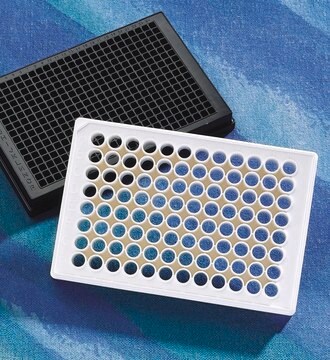P6403
Poly-D-Lysin -hydrobromid
suitable for cell culture, Mol wt 4,000-15,000
Synonym(e):
D-Lysine homopolymer hydrobromide
About This Item
Empfohlene Produkte
product name
Poly-D-Lysin -hydrobromid, mol wt 4,000-15,000
Form
powder or solid
Qualitätsniveau
Mol-Gew.
4,000-15,000
Methode(n)
cell culture | mammalian: suitable
Farbe
white to light yellow
Lagertemp.
−20°C
SMILES String
O=C(C)[C@@](NC)([H])CCCCN.[Br]
InChI
1S/C6H14N2O2.BrH/c7-4-2-1-3-5(8)6(9)10;/h5H,1-4,7-8H2,(H,9,10);1H
InChIKey
MEXAGTSTSPYCEP-UHFFFAOYSA-N
Suchen Sie nach ähnlichen Produkten? Aufrufen Leitfaden zum Produktvergleich
Anwendung
Dieses Produkt wird zur Verwendung als Trägerschicht (Substratum) in der Zellkultur empfohlen, wenn 0,5–1,0 ml einer 0,1 mg/ml Lösung zur Beschichtung von 25 cm2 verwendet werden. Produktausführungen mit niedrigerer Molekülmasse sind weniger viskos, Ausführungen mit einer höheren Molekülmasse bieten jedoch mehr Bindungsstellen pro Molekül.
Biochem./physiol. Wirkung
Komponenten
Vorsicht
Angaben zur Herstellung
Lagerklassenschlüssel
11 - Combustible Solids
WGK
WGK 3
Flammpunkt (°F)
Not applicable
Flammpunkt (°C)
Not applicable
Persönliche Schutzausrüstung
Eyeshields, Gloves, type N95 (US)
Analysenzertifikate (COA)
Suchen Sie nach Analysenzertifikate (COA), indem Sie die Lot-/Chargennummer des Produkts eingeben. Lot- und Chargennummern sind auf dem Produktetikett hinter den Wörtern ‘Lot’ oder ‘Batch’ (Lot oder Charge) zu finden.
Besitzen Sie dieses Produkt bereits?
In der Dokumentenbibliothek finden Sie die Dokumentation zu den Produkten, die Sie kürzlich erworben haben.
Kunden haben sich ebenfalls angesehen
Artikel
Humankind has utilized protein materials throughout its existence, starting with the use of materials such as wool and silk for warmth and protection from the elements and continuing with the use of recombinant DNA techniques to synthesize proteins with unique and useful properties.
Unser Team von Wissenschaftlern verfügt über Erfahrung in allen Forschungsbereichen einschließlich Life Science, Materialwissenschaften, chemischer Synthese, Chromatographie, Analytik und vielen mehr..
Setzen Sie sich mit dem technischen Dienst in Verbindung.






